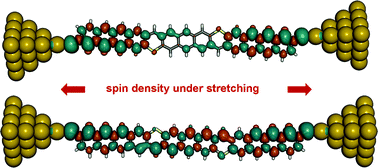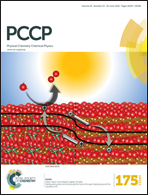Strain-induced spin crossover and spin-polarized currents in a prototype graphene nanoribbon†
Abstract
Graphene nanoribbons with well defined edges have been shown to possess high conductivities and behave like a quantum wire. Methods from synthetic organic chemistry have successfully been applied to produce such nanoribbons with smooth and chemically stable edges by saturation with hydrogen. Herein, we present ab initio calculations in a family of molecules related to the thinnest graphene nanoribbon, substitutionally doped with sulfur, for which synthetic methods are available. We show that sulfur doping can suppress the polyradical nature of these molecules. A strain-induced transition to a magnetic state is predicted for some of the studied molecules, at elongations as low as 1 Å. The transport properties were calculated using the Landauer–Imry elastic scattering theory. It is shown that in the strain-induced magnetic state, the molecular conductance associated with the minority spins is three orders of magnitude larger than that of the majority of the spins, thus providing evidence of a graphene nanoribbon spin filter.


 Please wait while we load your content...
Please wait while we load your content...